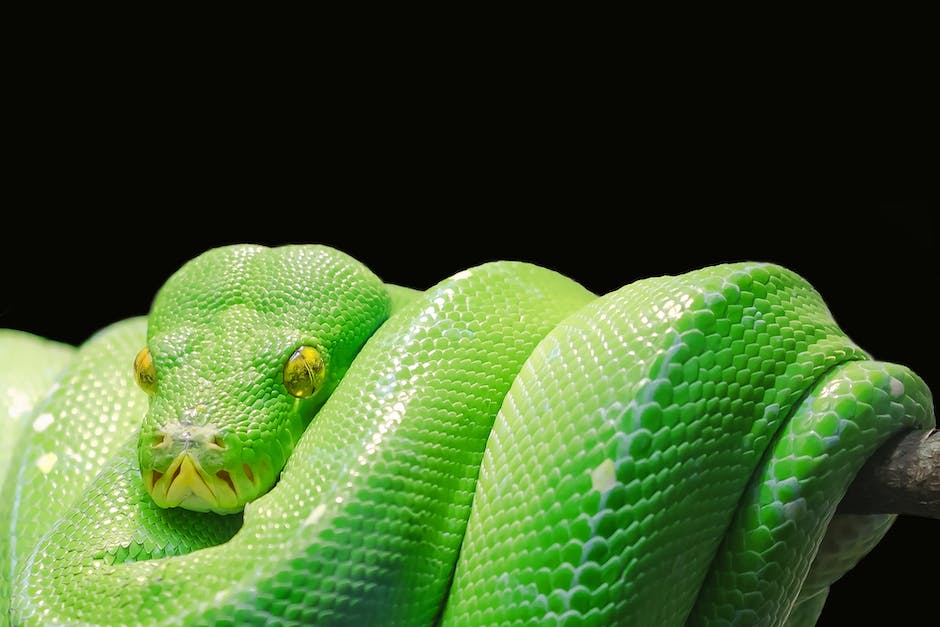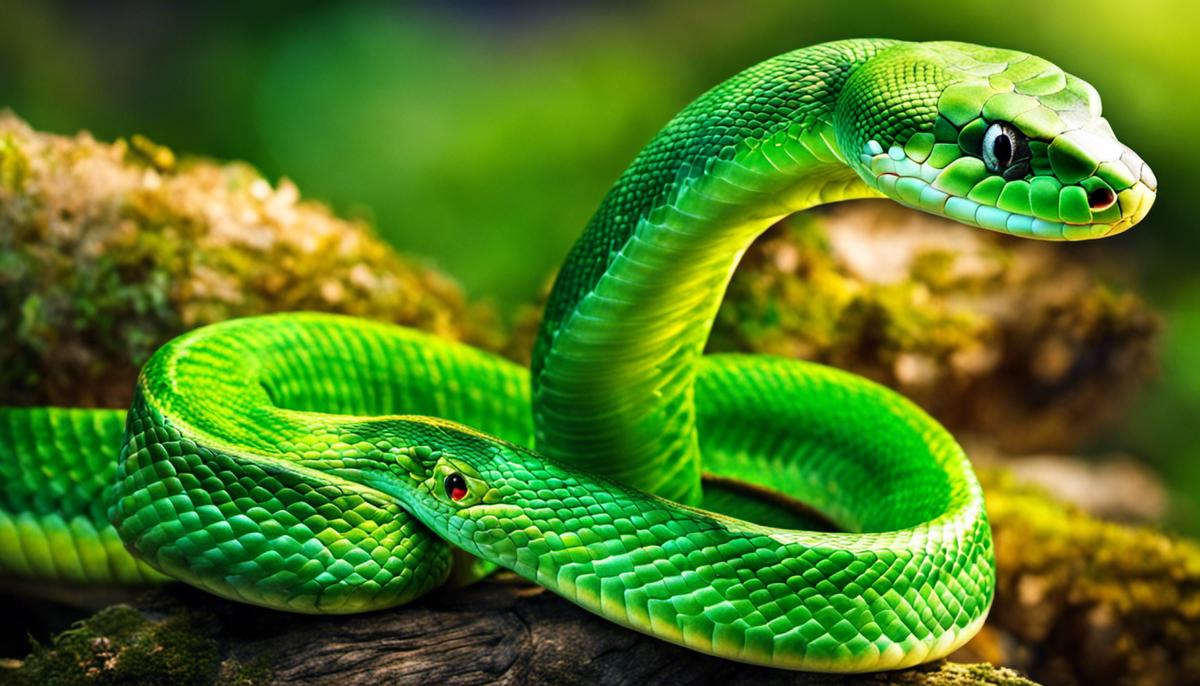Delving into the intricate world of dreams and their interpretation, one is often confronted by motifs that carry profound symbolism, with one such motif being the depiction of green snakes. Ancient texts, particularly the Bible, offer rich insights into the interpretation of such symbols. To shed light on this fascinating and deeply symbolic entity, it is essential to explore the recurring symbol of snakes within the context of the Bible, closely linked with sin, temptation, and wisdom. This juxtaposed with the biblical symbolism of the color green associated with fertility, life, and beginnings leads to a complex and meaningful analysis. Furthermore, an investigation of the diverse cultural variations in these interpretation brings another layer of understanding, as does the application of these interpretations through practical case studies.
Understanding the symbolic significance of snakes in dreams from the Bible
The interpretation of dreams, often known as oneiromancy, is a vast field as complex, rich, and varied as our dreams themselves. When exploring the realm of dream interpretation, and indeed focusing specifically on biblical dream interpretation, a recurring motif of note is that of the serpent, or snake. This article will dissect and analyze the symbolism and meanings behind the presence of snakes in biblical dream narrative.
An undeniable symbol throughout the Bible, the snake, in its genesis, is associated with deceit and trickery, as solidified by the tale of Adam and Eve in Genesis, where the serpent successfully tempts Eve to bite the forbidden fruit. Consequently, the snake, as a dream symbol, often represents damning elements such as temptation, treachery, and deceit. It’s essential, however, to avoid a simplistic correlation between snakes and universally negative connotations, as the interpretation of dream symbols can considerably vary depending on context, content, and personal sentiments.
In certain instances, biblical dream interpretation of snakes could denote transformation and healing. This particular correlation traces back to the image of Moses’ brass serpent, which granted healing to those who looked upon it, as detailed in Numbers 21:9. Snakes, in their shedding of skin, are commonly seen as symbols of renovation and rebirth. Thus, the appearance of a snake in dreams might refer to personal growth and transformation.
The dreamer’s feelings toward this dream serpent should not be overlooked, as this inherent emotional response could offer insight into the dream’s message. For example, if the dreamer feels contempt or fear toward the snake, it could imply looming deceit or treachery in their life. In contrast, a sense of tranquility or indifference towards the dream snake might hint at a need for personal growth and transformation.
In more specific biblical interpretations, snakes can symbolize chaos, evil, sin, and temptation. The infamous image of the serpent in the Garden of Eden, tempting Eve with the forbidden fruit, casts a long shadow and results in these negative connotations. Thus, a snake in a dream can often symbolize a struggle with temptation or an encounter with something or someone deceiving or harming the dreamer.
However, like all dream analysis, specificity is crucial. The snake’s behavior, color, size, and interaction with the dreamer are all factors that can profoundly shift the interpretation. For instance, a biting snake might denote feelings of betrayal, while a dead snake could signify overcoming adversity.
In conclusion, biblical dream interpretation of snakes is a multidimensional endeavor. Although snakes traditionally have negative connotations, like deceit, they can also suggest positive transformation or healing depending on the dreamer’s response and context. As a metaphor woven deeply within the biblical narrative tapestry, the snake invites us to contemplate our moral choices, personal transformations and introduces us to the likely faces of deception and treachery amidst our journey in the waking world.

The specific meaning of green snakes in biblical dream interpretations
Subsequent to the rich discussion on the symbolism surrounding biblical dream snakes thus far, the following section will delve into the nuanced implications of their color – specifically, green. Color injects a profound layer of interpretation in the dream narrative, anchoring the symbol’s meaning within specific spiritual or emotional contexts.
The color green in biblical interpretations is generally associated with life, fertility, and renewal. Green is widely represented in nature, signifying abundance and growth; it draws a parallel with the vitality of the human spirit. Probing into the Old Testament, Psalm 23 beautifully describes pastures of green where comfort and restoration abound, forging the connection between green and spiritual enlightenment.
Transitioning from the broader understanding of green as a signifier of life, When amalgamated with the figure of the snake in a dream narrative, the earlier discussed dual symbolism of snakes is refracted through this “lens” of green. The immediate interpretation hinges precariously on a continuum between life-giving and destructive forces.
The snake, already associated with healing and transformation, can be perceived more positively when painted with this verdant hue. Such a dream may imply an individual’s current state of personal growth, healing, or transformation. The green snake, in this context, could serve as an indicator of one’s progress, marking their transformation from old, outdated ways of thinking to fresher, fertile, and more productive perspectives.
However, depicting snakes as green could also amplify the negative connotations of deceit linked to these creatures in biblical dream symbols. Evoking images of vibrant Eden turned hostile by the serpent’s ploy, a green snake might reflect trickery masked in attractive, promising disguises – deceit bedecked in the vibrant hues of life and opportunity.
Additionally, contemplating upon the snake’s interaction with the dreamer and its behavior, as underscored in the prior discussion, will unveil additional depth in understanding these interpretation spectrums. A peaceful, non-threatening green snake might tilt the interpretation toward personal growth and renewal, while an aggressive or intimidating one could suggest deception or negativity emerging from seemingly positive circumstances.
A noteworthy factor, as previously highlighted, is the necessity of the dreamer’s subjective feelings and reactions. Individual sentiment toward green and snakes, personal experiences, and cultural background are pivotal in steering the interpretation.
In summation, the complexities of interpreting a green snake in dream symbolism lies in the biblical amalgamation of two potent symbols – the snake and the color green. With green implying life, renewal, and deceit when merged with snakes, it further enriches and complicates the multidimensional symbol, opening an expansive horizon of interpretation possibilities. The key is to weld the broader connotations with the personal sentiments and experiences of the dreamer, thereby deriving an interpretation that is as unique as the dream itself.

Cultural variations in the conceptualization of green snakes in dreams
The cultural lens through which a dreamer interprets their dreams can significantly shape the attributed meaning. When examining the symbol of a green snake in biblical dream interpretations, cultural variations play an essential part. This interplay of culture and symbolic interpretation is a profound testament to the inherent multidimensionality of dream symbolism, layered with personal sentiments, wider cultural narratives, and lived experiences.
The interpretation of a green snake is notably influenced by the cultural perspective on the color green itself. In Western cultures, green often signifies growth, renewal, and life— sentiments echoed in biblical lore like Psalm 23, where green pastures symbolize spiritual relief and sustenance. However, Eastern cultures might associate green with youth, new beginnings, or even exorcism and protection against evil in specific contexts. Therefore, a dreamer from an Eastern culture might interpret a green snake as a symbol of emerging opportunities or a protective force, contrasting with the Western interpretation.
The symbolic connotation of snakes is often underpinned by broader cultural narratives. Considerable variation is found across different cultures: some perceive snakes as symbols of wisdom or guardianship, such as in ancient Chinese or Native American traditions, while others perceive them as evil entities or agents of deception, reflecting the Judeo-Christian narrative. Such perspectives can alter a dreamer’s perception of a green snake; it could embody wise advice for some, while for others, it might herald deceit concealed in a promising situation.
Contextual factors such as one’s cultural exposure to snakes also influence interpretation. In cultures where humans and snakes coexist closely, the snake might symbolize harmony with nature or community wisdom, reflecting shared experiences with the reptile. Such cultural contexts could steer the dreamer towards perceiving the green snake as an emblem of communal wisdom.
The interaction between the dreamer’s personal experiences and their cultural framework often serves to compound the symbolic interpretation. An individual who has experienced personal growth may associate the green snake with personal transformation or healing, consistent with snake symbolism for renewal in their cultural cogitation. By the same token, a person with negative experiences involving deceit might perceive the green snake as a warning against deceit, reflecting their personal sentiments fortified by cultural acceptations.
To conclude, the interpretation of a green snake in biblical dream narratives is a complex, multifaceted process. It involves intertwining individual sentiments with far-reaching cultural perceptions, presenting a symbiotic reflection of individual psychology and societal connotations. The dynamism of the cultural backdrop significantly influences the symbolic understanding of a green snake, offering another testament to the diverse and intricate nature of dream symbolism in biblical interpretations. Thus, any attempt to decipher dream symbols must recognize this complexity and appreciate the interplay of personal sentiments and culture. It is the unique tapestry woven by these threads of meaning that ultimately illuminates the symbolism of a green snake in dreams.

Practical application of biblical dream interpretation: Case Studies
Interpreting biblical symbols, specifically the imagery of snakes in dreams, has fluidity by nature and multifaceted dimensions that intertwine on a deeply personal level with the dreamer’s life. Accommodating for the breadth and depth of interpretation, the symbolism of green snakes further expands the complexity of biblical interpretations. Particularly in relation to the color green, the universal potency in symbolic signification emerges, illuminating possible real-world applications.
Green, primarily in the biblical context, is recurrently associated with notions of prosperity and spiritual growth, leading to instances of this hue being employed to signal periods of await for increased blessings and bounty. In an analogous manner, dreams of green snakes may signify a looming period of personal or spiritual growth. The dreamer might anticipate a season of prosperity or enlightenment, akin to the ‘green pastures’ referred to in Psalm 23.
In real-world scenarios, one could interpret such a dream as an invite to engage more deeply with personal development, spiritual growth, and cultivation of virtues. Perhaps the dreamer is entering a phase where they are encouraged to seek wisdom, peace, or healing. Aiming for spiritual enlightenment too can form an integral part of this scenario, building upon the foundational concept of green as a catalyst for growth in nature and in spirituality.
In the face of possible negative connotations for green snakes—tricking, seduction, or deceit—one might examine the need to remain vigilant, promoting discernment in our relationships to avoid falling prey to deception. Equally important is the consideration of a dreamer’s subjective feelings upon dream entanglement with the green snake – fear, intrigue, or exhilaration – as each reactionary emotion can lend additional insights into the symbolic interpretation.
Simultaneously, cultural narratives shape individual perspectives on symbols, thereby influencing the interpretation of dreams. The symbolism of green and snakes differs across Western and Eastern cultures, enriching the interpretative context. West largely views snakes with a tinge of negativity—suspicion, fear, or treachery—while Eastern narratives often treat snakes as carriers of wisdom and transformation. These inherent societal views, refracted through personal experiences, establish a unique interpretative environment for every dreamer.
Real-world applications of these interpretations could take form in being prudent in decision-making, acknowledging the importance of wisdom, or preparing oneself for significant life transformations. This propensity towards self-growth and self-improvement may manifest across various spheres—personal relationships, career advancements, or spiritual journeys.
In all their complexity, green snakes’ appearances in dreams demand attention—an invitation to delve deep into the layered and nuanced interpretations and discern its connection to the dreamer’s real-world scenario. Every dream works as a mirror, reflecting the life of the dreamer, their unconscious feelings, desires, fears, hopes, and when interweaved with biblical symbolism and personal interpretations, it offers profound insights into human life. This coming together of personal experiences and societal connotations encourages multi-perspectival understanding—a multi-modal lens, charting the diverse terrain of biblical dream symbolism.
In conclusion, the nuances of interpreting green snakes in biblical dream symbolism are wide-ranging, encapsulating both the shadowy abyss of potential deceit and the sunlit field of personal and spiritual growth. Bridging the gap between the expanse of biblical symbolism and real-world scenarios, individuals can harness these interpretations to navigate through the labyrinth of life, understanding their path better and perhaps, finding healing along their journey.

Dream interpretation, especially when it pertains to biblical symbolism, uncovers layers of meaning with universal and personal ramifications. The green snake, as was discussed, serves as a potent symbol, with the serpent echoing biblical undertones of temptation and wisdom, while the color green represents life and new beginnings. The multifaceted interpretations of this symbol across different cultural spaces further enriches its significance. Through the lens of practical case studies, we can appreciate how these interpretations are not mere theoretical constructs, but living narratives that shape and are shaped by human experiences. Thus, understanding the symbolism of green snakes in dreams is illuminating not only to explore biblical interpretations but also to comprehend our deep-rooted cultural and individual narratives.








